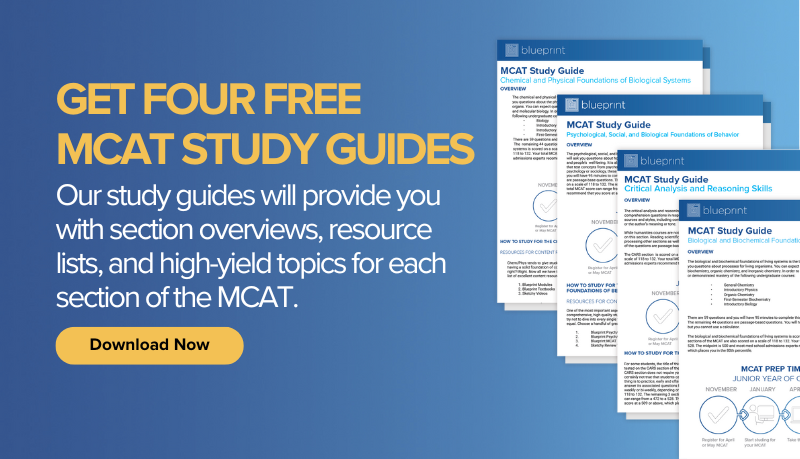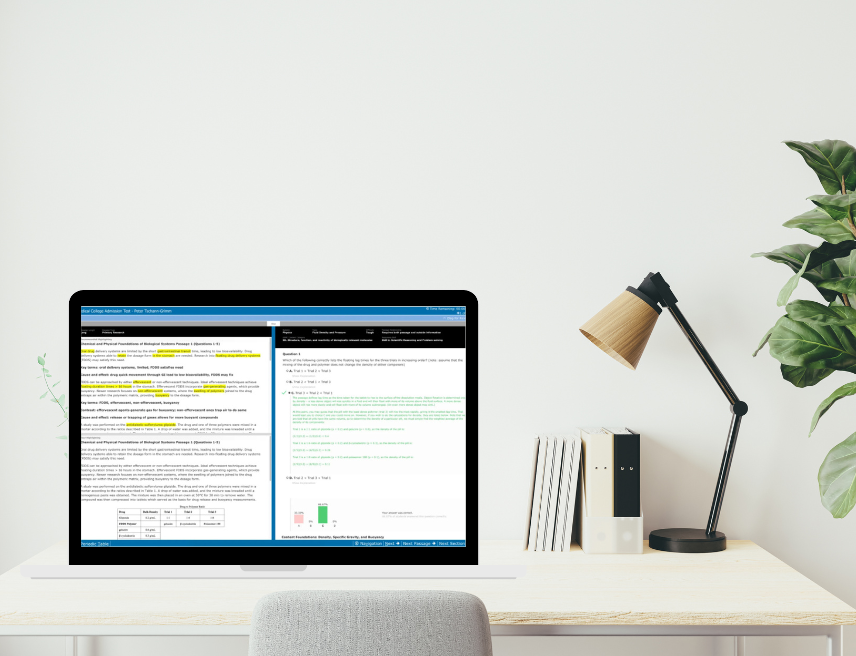When it comes to the MCAT Chem/Phys and Bio/Biochem sections, it is essential to understand MCAT lab techniques and how they may appear in passages or questions. Of these, separation techniques are high-yield and important to be familiar with. They allow scientists to isolate, identify, and analyze compounds in complex mixtures.
These techniques are rooted in principles of chemistry and physics. Having a strong understanding of them can give you an edge on the test. In this blog, we’ll cover the most commonly tested MCAT lab separation techniques you may encounter on test day, including:
- Chromatography (Thin-Layer, Gas, Liquid, and Column Chromatography)
- Distillation
- Extraction
- Filtration
- Centrifugation
High-Yield MCAT Lab Separation Techniques
Chromatography
Chromatography is a technique used to separate compounds based on differences in their affinity for a stationary phase (solid or liquid that doesn’t move) and a mobile phase (liquid or gas that moves through the stationary phase). There are various forms of chromatography. However, you should be familiar with at least the following four types.
1. Thin-Layer Chromatography (TLC)
Principle: TLC is used to separate compounds based on polarity. It involves a stationary phase (usually a polar silica gel) and a mobile phase (a nonpolar solvent). Compounds travel up the stationary phase, and their movement depends on their polarity. Polar compounds interact more with the stationary phase, while nonpolar compounds travel farther with the mobile phase because they interact less with the stationary phase.
MCAT Application: You might be asked to analyze a TLC plate and determine which compound is more polar based on the distance traveled. Calculating Rf values (the ratio of the distance traveled by a compound to the distance traveled by the solvent front) is a common question type.
2. Gas Chromatography (GC)
Principle: This method separates volatile compounds based on boiling point and polarity. A sample is vaporized and carried by an inert gas (the mobile phase) through a column packed with a stationary phase. Compounds with lower boiling points or less interaction with the stationary phase travel faster.
MCAT Application: You could be asked to interpret a gas chromatogram or predict the order in which compounds will elute based on their boiling points and molecular weights.
3. Liquid Chromatography (LC) / High-Performance Liquid Chromatography (HPLC)
Principle: LC and HPLC separate compounds in the liquid phase. HPLC, in particular, uses high pressure to push the mobile phase through a column, which provides faster and more precise separation. Compounds are separated based on their interactions with the stationary and mobile phases.
MCAT Application: Expect questions on comparing retention times of compounds or understanding the role of different types of stationary phases in separation (e.g., reverse-phase HPLC, where the stationary phase is nonpolar, and polar compounds elute faster).
4. Column Chromatography
Principle: Similar to TLC, but used for larger-scale separations, column chromatography separates compounds based on polarity. The stationary phase (silica or alumina) is packed in a column, and the mobile phase (a solvent) carries the compounds through the column.
MCAT Application: You may be asked to rank compounds in terms of elution order based on their polarity or predict how changing the solvent system might affect separation efficiency.

Distillation
Distillation is used to separate liquids based on differences in their boiling points.
1. Simple Distillation
Principle: In simple distillation, a mixture of liquids is heated, and the more volatile (lower boiling point) component vaporizes first. The vapor is condensed and collected in a separate container.
MCAT Application: Simple distillation is best for separating compounds with large differences in boiling points (generally > 25°C). You may encounter a question asking when to use simple distillation vs. fractional distillation.
2. Fractional Distillation
Principle: This method is used for separating liquids with closer boiling points. A fractional column is added to increase the efficiency of separation, allowing for multiple vaporization-condensation cycles.
MCAT Application: You could be asked to compare fractional and simple distillation or explain the use of a fractional column to improve separation.
Extraction
Extraction is a technique used to separate compounds based on their solubility in different immiscible (incapable of being mixed together) solvents (usually an aqueous and an organic phase).
Principle: Compounds are separated by shaking them in a separatory funnel with two immiscible solvents. The compound will distribute itself between the two solvents based on its solubility in each.
MCAT Application: You might be asked to identify which solvent a particular compound will dissolve in (e.g., polar compounds dissolve in water, nonpolar compounds dissolve in organic solvents) or to perform acid-base extractions where acidic or basic compounds are extracted into the aqueous phase after protonation or deprotonation.
Sign up to get expert tips and exclusive invites to free MCAT classes and medical school admissions workshops!
Filtration
Filtration is used to separate solids from liquids.
Principle: In gravity filtration, the mixture is poured through a filter paper, where the solid remains on the filter, and the liquid passes through. Vacuum filtration speeds up the process by using reduced pressure.
MCAT Application: Expect straightforward questions where you need to choose the appropriate filtration technique or explain the role of vacuum filtration in improving efficiency.
Centrifugation
Centrifugation is used to separate components in a mixture based on density.
Principle: A sample is spun at high speeds, creating a force that causes heavier components to sediment at the bottom while lighter ones remain in the supernatant.
MCAT Application: Questions may involve interpreting a centrifugation experiment or identifying factors that influence the efficiency of separation (e.g., speed of centrifugation, size, and density of particles).
Final Thoughts
Understanding these MCAT lab techniques is crucial for success. Be sure to memorize how each technique works, as well as understand the underlying principles. Practice interpreting experimental data, visualizing chromatograms, and predicting how changes in experimental conditions could affect the outcome. Mastery of these topics can significantly improve your performance in the MCAT’s experimental passages. It also makes it easier to parse apart the methods sections in the experimental passages you read.
If you need more help with MCAT Chem/Phys and Bio/Biochem sections or any other MCAT topics, our experts are here to help! Whether you need the flexibility of a Self-Paced Course, the instruction of a Live Course, or 1:1 assistance of a private MCAT tutor, Blueprint MCAT has the MCAT prep option that works for your learning style!
Get started with a free MCAT diagnostic, one free practice exam, and tons more MCAT prep resources.




